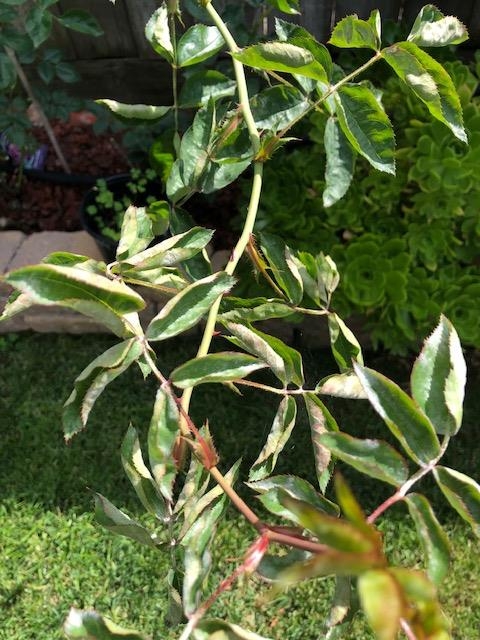
MGCC Help Desk Response: Thank you for contacting the Help Desk of the UC Master Gardener Program of Contra Costa County. Based on the photo you provided, it is likely that your rose are infected by Powdery mildew (Podosphaera pannosa). This fairly common fungi produces mycelia and spores on leaves and shoots, and sometimes on flowers. It looks like a gray (older infections) or white (newer infections) powder on both sides of the leaves, differentiating from Downy mildew, which tends to appear only on the underside of the leaves.
Powdery mildews spread with windblown spores. They do not need water to germinate and die when wet for an extended period. They like moderate daytime temperatures (60-80 degrees F), cold nights and shady and low light conditions. UC Agriculture and Natural Resources (UCANR) recommends a number of measures to control infestations but once a plant has extensive infections it is usually too late to control and prevent damage to the plant. It is hard to determine from the photo how badly infected your rose is, but the following recommended measures may be helpful in managing it.
- Prune during the dormant season to increase air circulation and light penetration. Trim or remove adjacent plants to avoid crowding.
- Remove infected plant parts to reduce spore production. This should be done when the plant is wet and the spores can't generate.
- Irrigate using an overhead sprinkler in the morning when the spores would otherwise be released.
- Some infections may require fungicides, these usually only prevent new infections and may need to be applied repeatedly when conditions favor disease development. Use less toxic pesticide products wherever possible and carefully follow instructions on proper use, storage and disposal to reduce adverse impacts to other species and the environment. Mild to moderate infections can be treated with horticultural oil or plant-based oils, such as neem oil. Do not apply in bright sunshine or when outside temperatures are 90 degrees or more as it may burn or otherwise damage the plant and some beneficial insects. Also, read instructions carefully on preventing harm to bees.
- Disease prevention can also be effective with the application of sulfur products, especially ready-to-use soap like surfactants. These are not effective once the disease has appeared.
If your plant is substantially infected, consider removing it and growing a more resistant cultivar and species. Some examples are Meidiland shrub roses, Rosa rugosa, glossy-leafed hybrid teas, grandifloras, that are trademarked as Care-free, Knock Out, and Home Run. Plant in a sunny location and provide ample adjacent open space for air circulation.
For additional information please see this link to UCANR Integrated Pest Management Program Pest Notes: http://ipm.ucanr.edu/PMG/PESTNOTES/pn7463.html
We hope this information is useful. Feel free to contact us again if you have any further questions.
Help Desk of the UC Master Gardener Program of Contra Costa County (NHP)
Note: UC Master Gardeners Program of Contra Costa's Help Desk is available almost year-round to answer your gardening questions. Except for a few holidays (e.g., last 2 weeks December), we're open every week, Monday through Thursday for walk-ins from 9:00 am to Noon at 2380 Bisso Lane, Concord, CA 94520. We can also be reached via telephone: (925) 608-6683, email: ccmg@ucanr.edu, or on the web at http://ccmg.ucanr.edu/Ask_Us/. MGCC Blogs can be found at http://ccmg.ucanr.edu/HortCoCo/ You can also subscribe to the Biog.